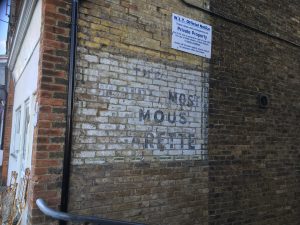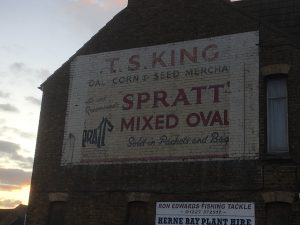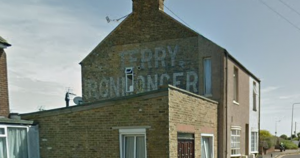As the majority of shops currently sit empty and high streets are stilled to an eerie quietness in the midst of the ongoing COVID-19 pandemic, fears have been raised over the overnight emergence of ‘ghost towns’ and the extent to which these will remain in light of the predicted economic downturn once the virus has (hopefully) been eradicated. Whilst the present situation has indeed thrown a spotlight on the way in which urban centres can become ghost-like, it is important to note that our towns and cities have been haunted long before the emergence of this pandemic. Ghost signs are one such way this is so.
Ghost signs are enduring remnants of advertising past. The term most commonly refers to old hand painted signage – such as those pictured below – found ubiquitously littered across the brickwork of towns and cities of predominantly post-industrial societies.




This form of advertising became popular in the later stages of the industrial revolution whereby mass production provided the need – and urbanisation provided the advertising space and concentrated footfall – to promote the new businesses and commodities flooding the market. However, by the middle of the 20th Century mass-produced billboard advertisements, which were much quicker and cheaper to manufacture and install, rendered the need for individualised hand painted signage obsolete. Consequently, the swathes of hand painted adverts already in existence – unless boarded up, built against, or whitewashed over – were left to decay at the mercy of the elements. As a result, the businesses and products represented by these signs typically no longer exist, meaning that their presence in the contemporary serves as a haunting reminder of places, items, and, most significantly, a time gone by.
Ghost signs, then, provide a fascinating insight into a very particular time window in history. Indeed, when beholding their interspersion amongst the typical high street comprised largely of multinational chains in the present day, the contrasting tailored individualism of the ghost sign reflects the former greater heterogeneity of urban centres which would have been comprised of small, independent local businesses at the point of their creation. In a similar vein, the fact that so many ghost signs contain the individual business owner’s name – such as the examples below – further reveals the greater localisation and personalisation of the former shopping experience whereby such names would have likely been well-known within their local communities.




Furthermore, whilst the establishment of the original signs would have naturally been primarily governed by the materials and techniques available for advertising at the time, their long-lasting nature nonetheless reveals something even more telling about the era in which they were produced. Specifically, the semi-permanent fusion of paint to brick arguably encapsulates the mindset of early industrial modernity and the widespread assumption in its dawning that societies organised around industrial capitalism would achieve perpetual progress. Accordingly, when considering that ghost signs are products of this era, it is arguably not unreasonable to assume that, at the point of their inception, the businesses and products represented by these signs were expected to last. By contrast, it is virtually unfathomable to imagine that a business opening today would be confident enough in lasting success to meld its name or products into its structure even if no other forms of advertising were available.
However, the optimism of early industrial modernity has been steadfastly eroded with each passing decade due to the inability of the capitalist machine to stay static and the devastating social consequences that have resulted from its incessant acceleration. In the last 40 years in particular, societies which were originally at the forefront of the industrial revolution have experienced widespread deindustrialisation as a result of the off-shoring of production of many industries to cheaper (i.e. heavily exploited) labour markets abroad, alongside technological automation which has rendered many previously skilled professions obsolete. In their place, watered down, non-unionised job equivalents have emerged with issues of in-work poverty, precarity and underemployment at endemic proportions within numerous sectors of post-industrial economies.
In addition, the progression of capitalism and rise of consumerism in the 19th Century led to many businesses which started their life as small independent shops, expanding to become local or national chains and, in some cases, national or international conglomerates in an increasingly globalised economy. Due to the ability of these larger companies to purchase huge quantities of stock from the cheapest countries of production, they are able to keep their goods prices low, rendering it exceptionally difficult for independent businesses to compete and subsequently leading to a gradual homogenisation of the high street. More recently, and corresponding with the rise of the car ownership, the greater ability of such companies to buy large areas of out-of-town land for retail units has tended to deflect business away from many urban centres. The consequences of this are particularly marked in areas where local authority investment in town centres is low, leading to high streets littered with empty shops in such locales.
Finally, and in parallel with the above developments, has also been the accelerating rise in consumer culture and, in particular, lifestyle advertising leading to cultural fads where clothes, toys and other accessories are popular for only fleeting moments in time. The resulting culmination of all of the above transitions is the reality in which live today; a hyper-mediated fast capitalism under which products, businesses and jobs can emerge and disappear virtually overnight. Interestingly, this instability is also reflected in the successors to hand painted adverts (e.g. billboards and retail fascias), which are designed and created with impermanence in mind and, as such, reflect the likely fleeting nature of what it is they are advertising under contemporary capitalism.
However, the coronavirus has exposed the vast flaws in our current way of living on a grand scale. Firstly, as the gravity of the pandemic became apparent and panic buying set in around early March, the major supermarket chains struggled to keep up with demand leading to widespread shortages of many essential household and food items. It was during this period that many independent retailers became a lifeline to their local communities as their smaller customer bases meant that they were more likely to have supplies of the items the larger supermarkets had run out of. Similarly, when supermarket delivery slots started being booked up weeks in advance, numerous local businesses transitioned into offering a temporary local delivery service which was a salvation to many, particularly those in the shielding category or who were otherwise self-isolating. Consequently, there appears to have been a surge in goodwill towards shopping locally with some data currently suggesting that up to 30% of people* would remain doing so long term (although naturally the extent to which this will occur after the resolution of the pandemic remains to be seen, especially in light of the inevitable further pressure upon household incomes).
However, arguably most significantly, the pandemic has given more people more time than ever to pause and reflect upon the way in which our world is organised. It has shone a light on the fact that the workers who have kept our countries going (e.g. those who work in social care, health care, retail and so on) work within job sectors in which issues of low pay, zero hours contracts and insecurity are prevalent. It has made many people realise that the material items they thought were important are perhaps not so valuable when there is a potential mortal threat to their families and the ability to source food. And with the economy ground to a virtual halt and fears of widespread job losses in the likely coming recession, trade union membership has substantially increased**. Accordingly, many people seem to have become awakened to the fact that perhaps there is an alternative to the way in which we live.
It is precisely during this time, before things go back to ‘normal’, that we need to look back to messages of the past to see how we’ve arrived at our current destination. In the same way that people in years to come will look back on surviving signs of the pandemic as a reminder of what life was like during it, we can look to ghost signs as a reminder that there was a period in recent history where there was a common underlying vision that a stable future was possible. And whilst their relegation to the past may be viewed by some as proof of the inevitability of Marx’s assertion that ‘all that is solid melts into air’ under contemporary capitalism, the lingering existence of the ghost sign can also be viewed as a symbol of hope that what once was envisaged still has the potential to be realised. Indeed, the optimistic future embodied in the ghost sign has gone unrealised not because of a natural inevitability of ‘progress’ but because of the wealth accumulation motivation of capital which, supported by contemporary political structures, has resulted in the mass inequality and social suffering we witness today.
Ghost signs are all around us. They are warning signs of the dangers of complacency. It is up us to take heed of these warnings and mobilise to rebuild a better future now.
Sources:
**https://socialistworker.co.uk/art/50121/Workers+rush+into+trade+unions+to+fight+profit+hungry+bosses